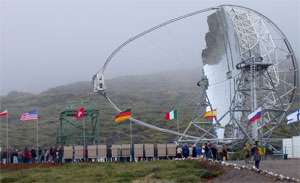MAGIC Telescope Finds Microquasar

The variable emission of high-energy gamma rays from a variable microquasar within our galaxy has been detected by the MAGIC (Major Atmospheric Gamma-ray Imaging Cherenkov) telescope located in the Canary Islands. The object is the first seen to fluctuate in the high-energy gamma spectrum, said Daniel Ferenc, professor of physics at UC Davis and a member of the MAGIC scientific team.
The microquasar LS I +61 303 probably consists of a normal star and an extremely dense object, either a black hole or a neutron star, Ferenc said. As the stars orbit each other every 26 days, matter is pulled from the regular star and spirals towards the other object. Jets of particles traveling at nearly the speed of light are blasted out as the material collapses in the gravitational field.
The MAGIC telescope measured gamma rays coming from the microquasar over about six months. New light detection technology allowed MAGIC to measure the microquasar's activity continuously during several 26-day orbits, despite the presence of moonlight. The brightest emissions occurred a few days after the point when the star and the black hole were closest together.
The results will help physicists understand how microquasars and quasars emit gamma rays, Ferenc said.
The MAGIC telescope, inaugurated in 2003 at La Palma in the Canary Islands, looks for objects that emit high-energy gamma rays from deep in the universe. It detects gamma rays by picking up the flashes of light given off as the rays hit the atmosphere.
The MAGIC team includes 130 scientists from nine countries. Ferenc's laboratory at UC Davis, including research fellows Daniel Kranich and Alvin Laille, has worked on camera design, mirror control and developing new types of photosensors for MAGIC and for a second telescope now under construction at the same site, as well as for the next generation of very large neutrino telescopes.
Eckart Lorenz, visiting professor at the Swiss Federal Institute for Research and a leader of the MAGIC project, also is an adjunct professor at UC Davis. The research was recently published online in Science Express.
Source: UC Davis




















